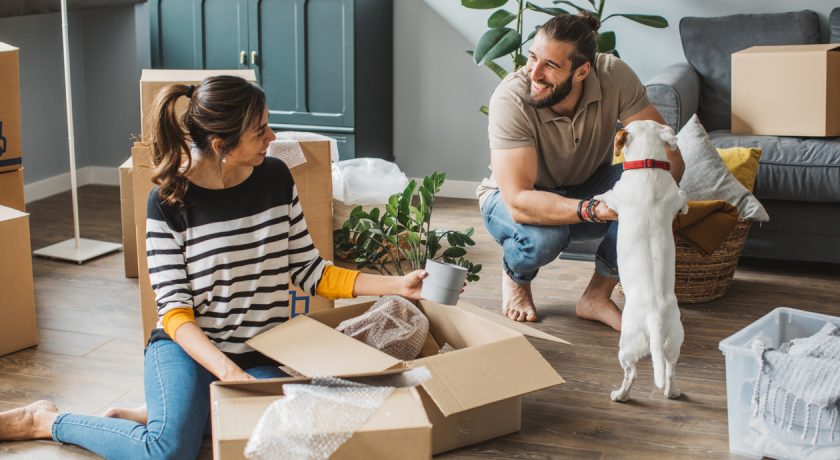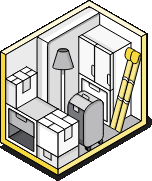How to Pack for a Move

Packing is often the most time-consuming part of moving. However, with careful planning, patience, and an honest assessment of your physical abilities, budget, and how much you really need to move, packing can be quite manageable.
Nevertheless, deciding where to start, what to pack, and which room to begin with can feel overwhelming. To make the whole moving process easier, it’s best to start preparing as early as possible, preferably several weeks before the move. You don’t want to procrastinate and then start to panic as the moving date gets closer. If you’re unsure where to begin, don’t worry –we have all the packing tips and tricks to help you pack for a move.
Donate or toss any items you don’t want or need
First things first: downsizing. Donating or tossing items you no longer want or need can help significantly shrink down how much stuff you will need to pack and move (and how much you’ll need to spend on packing supplies!).
You can do this either while you’re packing or before you start. You’ll want to go through your belongings room by room, starting with the biggest items first, and decide which items you want to keep and which ones you want to either donate, sell, or throw away. Sort them into separate, identifiable piles, or add labels or sticky notes to the bigger items so you know which items are for donation, selling, or tossing.
Donating
Place items for donation in extra boxes or large bags and drop them off at your local donation drop-off centre or charity. Remember, one man’s trash is another man’s treasure! If you’re donating large items like furniture and rugs, arrange a pickup in advance. Keep any donation receipts because you might be able to claim the donation on your taxes.
Selling
If you have the time and energy, consider having a garage sale. Tell people about it with signs, flyers, and social media posts. Invite your neighbours, set fair prices, and put out all the good stuff you don’t need anymore.
If you’re hoping to sell a bunch of used clothing that’s still in great condition, you can look up second-hand consignment shops around where you live and try to get some money back that way. You can also look into selling your second-hand clothing online using sites like Poshmark or Depop.
Another option is to try selling your other items online through sites like eBay, Craigslist, Facebook marketplace, or Kijiji. You could even join local Facebook groups that allow you to post items you’re selling to try to sell them faster.
Tossing
Collect all the items you don’t think are worth selling or donating and bring them to your local dump. If you have too much stuff to throw away, you could also look into hiring a professional junk removal company. They can clean out your home or garage and bring heavy items to the dump for you. They may even donate your items to local charities for you if they feel they’re worth it.
Create an inventory list
The best way to pack for moving is to start with a list of all your belongings in each room. This will help you determine what packing supplies and other moving tools you need. It also helps with moving estimate costs if you plan to hire movers. It’ll give them a better idea of how much stuff they’ll need to move and how big of a truck you’ll need.
Another reason to create an inventory list is to help you stay organized. A good inventory list helps keep track of all your items, making it easy to find things and ensuring everything arrives safely. If anything goes missing, having a detailed list and pictures of your items can help the moving company find and return them.
Begin by going room by room, creating a list, and taking pictures of everything you own. Consider using programs like Microsoft Excel or Google Sheets to help make sorting and organizing everything easier.
Gathering packing supplies
Now that you have a list together of everything you’ll need to pack, you’ll want to purchase and gather up all the moving supplies you’ll need to do it. Some of the items you’ll need include:
- Boxes
- Packing tape
- Packing paper or newspaper
- Stretchy plastic wrap
- Bubble wrap
- Plastic bags and garbage bags
- Blankets
- Tools to help disassemble furniture
- Labels and markers
When buying boxes, remember you’ll need different sizes and a few special ones. Professional moving boxes come in various shapes and sizes to fit different household items. Use wardrobe boxes for hanging clothes and special boxes for mirrors and wall art. If you have the original boxes for your TV, electronics, and appliances, you can use those.
Here’s a tip: to save money on packing supplies, look for free options. Boxes, especially, are often easy to find for free. Check local stores, your office, and online places like Facebook Marketplace or even Kijiji. Ask around your friends, family, and neighbours if they have any moving supplies they don’t need.
Begin packing, room by room
When starting to pack your belongings, the best way to begin is to go room by room. The order is up to you. Some people suggest starting from one corner and working to the other, while others recommend packing the storage room first since it has non-essential items.
Focus on one area of a room at a time, and don’t mix items from different rooms in one box. This way, you can label each box with the room it will go to in your new home. You can also colour-code your boxes using a label or specific coloured marker for each room, making it much easier to spot and move when unloading the truck.
Make sure you clearly mark the outside of your boxes with the destination room, the contents, and if they’re fragile. Mark both the top and the sides of each box for easy visibility.
Now that we’ve covered how to properly label boxes, let’s start packing room by room.
Living room and dining room
First, let’s start with the living room and dining room or den.
Furniture
There are lots of different types of furniture found in living rooms and dining rooms. Here’s what to do with the most common:
Shelves and desks
The first place to start packing in a living or dining room is your shelves and desks. These often contain non-essential objects like figurines, smaller photographs, books, or miscellaneous papers and items. Clear off your shelves and empty your drawers, packing these items in labelled boxes and adding bubble wrap, newspaper, or linens like towels or face cloths around any breakable items. Then, remove the drawers and disassemble your desk or shelves. Place the hardware in labelled plastic bags and secure it on its shelf or desk. If you cannot remove the drawers, use rope or string to keep them shut.
Hutches and china cabinets
These are another great place to start, as they’re often used for storage or displaying fine china that isn’t used often. Start by emptying the shelves and cupboards, making sure to pack fragile items away safely using towels or bubble wrap. Then, you’ll want to secure the doors. Your first thought may be to use tape or plastic wrap, but both of these can cause damage to the wood. Instead, it’s best to tie the doors closed using rope or string by either tying the handles together or wrapping them tightly around the entire hutch or cabinet.
If your china cabinet has glass shelves or pieces in its doors, it’s best to remove them. Cover the doors/shelves with packing paper and then place cardboard cut to the size of the glass on both sides of the glass, securing it in place. The packing paper will prevent the tape from leaving any sticky residue on the doors while securing the cardboard. Next, add extra cardboard to each corner and cover the door/shelf in bubble wrap. Finally, find a box of a similar size to pack them inside.
Couches
As for couches, if yours is made of light fabric like cotton or linen, you can cover it with a sofa cover to protect it from dust or dirt. Then, you can secure the cover with stretchable plastic wrap. For leather couches, avoid using plastic wrap and instead use moving blankets secured with tape, as leather needs to breathe. Just make sure you’re taping the blankets and not the leather to avoid leaving any sticky residue. If your couch has sharp corners or edges, you can add some cardboard for extra protection. If it has longer legs, you may want to remove them. As for throw pillows, you can toss them in a large plastic bag.
Coffee tables
If you have a wooden coffee table, you’ll want to avoid using plastic wrap as it can cause damage. Instead, use soft, non-scratch moving blankets or even old blankets to wrap and cushion it.
If it has a glass top, remove the glass piece from the table, then cover the entire glass surface with packing paper and tape it (but don’t tape directly on the glass). Next, cut cardboard to the same size and shape as the glass and place it on both the top and bottom, securing it in place. Add extra cardboard to each corner, and then cover the whole thing in bubble wrap. If you cannot remove your glass top from the table, still do your best to protect it, as explained above.
Dining room tables and chairs
You can often remove the legs from dining room tables, so that’s the first place to start. You can wrap them together in a blanket or bubble wrap. Place the hardware in a plastic bag and secure it to the underside of the table. Then, you can follow the same steps as wrapping a coffee table, including if your dining room table has a glass top.
As for dining room chairs, start by removing the legs and wrapping them up. If the legs can’t be removed, wrap them carefully with moving blankets or furniture pads. Secure the wrapping tightly by covering each leg with padding and plastic wrap, ensuring the outline of each leg is visible. Don’t forget to attach the hardware.
Electronics
For your electronics in the living room, you likely have an entertainment setup, maybe with a TV, gaming consoles, a surround sound system, or even a desktop computer. Before you begin unplugging cables, make sure you take photos of the back where they’re all plugged in to make setup easier at your new home. You can also want to colour-code the wires so you can easily identify which ones go to which electronic device. As for the computer, you may want to back up the hard drive just in case the computer is damaged during transit.
When packing up the TV or computer, if you still have the original boxes, use those to pack them up safely. Pack boxes with packing paper, blankets, or bubble wrap to help keep them from shifting around if the boxes no longer contain the styrofoam they came with. If you no longer have the boxes, you can purchase special boxes specifically for moving TVs and computers. Otherwise, for the TV, you can wrap it in a thicker blanket, like a comforter or duvet, to provide enough padding during transit.
Lamps
If you have any lamps, you’ll want to remove the bulbs before moving them, as they may break during transit. To keep them safe, put the bulbs in a box wrapped with bubble wrap or kitchen towels. Then, if you can, disassemble the lamps before packing them.
Rugs
You’ll first want to vacuum any area rugs you plan to bring with you. Then, roll them up as tight as you can and secure them with packing tape.
Artwork and picture frames
If you have any pieces of artwork or framed photographs on the wall, remove them and give them a good dusting. Then, wrap them with packing paper or bubble wrap to protect them and add extra cardboard to the corners. Your best bet for packing them is to match them with similar-sized boxes, as leaving them outside of a box increases the risk of damage. Depending on the thickness of the box, you can use the same box to pack multiple items. The packing paper and bubble wrap around each item will not only protect them from scratches but also help keep them from shifting around inside the boxes. Finally, don’t forget to reinforce the bottom of the box(es).
Bedrooms
Now, let’s move on to the bedrooms.
Clothing
When it comes to bedrooms, it’s a good idea to start with clothing. Leave out enough clothes to last a few days (you can wash them, after all), and get ready to pack the rest. The great thing about dressers is you can leave your clothes in the drawers, but you may still want to place them in plastic bags to avoid any dirt or dust accumulating on them during the move. You can also use laundry baskets when packing clothes. However, if you wish to leave them in the drawers, another option is to wrap the entire drawer in plastic wrap once you’ve removed it from the dresser to keep them from falling out. Consider rolling your clothes instead of folding them to help space space.
For your closet, it’s easiest to leave clothes on hangers. You can use a wardrobe box or even large plastic bags. This makes it easy to move them from the box to the closet without needing to re-wash everything. Plus, it’s best to avoid using cardboard boxes to move clothing as it can make the clothes smell like cardboard or whatever the box was previously used for.
Beds and linens
If possible, wash your bedding before packing. For blankets, sheets, pillowcases, and other bedding, use large garbage bags. For linens, you can also use plastic bags or suitcases. You might want to keep some of your blankets out for moving day, though, as they can help protect corners and edges of furniture from getting scratched.
Then, take apart the bedframe and set it aside. You can sleep on the mattress on the floor until moving day. Make sure you place all of the hardware in a plastic bag and tape it to the bedframe so you don’t lose it. If you don’t have a mattress bag, put a fitted sheet over the mattress to keep it clean during the move.
Dressers and mirrors
It’s best to start by removing the drawers from all dressers to help lighten the dresser for moving. However, some furniture pieces don’t have removable drawers. In that case, you’ll want to empty the drawers to make the move lighter. Then, you’ll need to secure the drawers and doors. While it’s common to use packing tape to keep them closed, it’s ideal to use rope or string to avoid sticky residue that could damage the furniture.
As for mirrors, start by removing them from the main furniture. Then, just like we explained with the coffee table, cover the entire glass surface with packing paper and tape it. Next, place cardboard cut to the same size and shape on both the top and bottom of the glass and secure it in place. If your mirror has corners, add extra cardboard to each corner. Finally, cover the entire mirror in bubble wrap.
Jewelry and fragile items
Depending on how much jewelry you own, you can easily pack it in your suitcase or carry-on bag and take it with you. This way, you’ll know exactly where it is, giving you peace of mind. If you don’t have soft jewelry bags, you can wrap your jewelry in tissue paper and put it in small plastic bags to prevent scratching. Here’s a fun tip: place thin necklaces inside drinking straws to prevent tangling, and use loose buttons to keep your earrings paired together.
Another option is to wrap your jewelry or fragile bedroom items inside your clothing before you pack it. Just make sure you keep it all together and label the box or drawer that you packed the clothing-wrapped jewelry in so that you don’t forget about it while unpacking and accidentally break something.
Home office
Electronics
When packing electronics, take photos of how all the cords are connected to ensure you can properly put them back together once you’ve moved. Avoid packing boxes too heavily and consider colour-coding wires for electronics when disassembling them. Because electronics are expensive, consider buying special boxes for computers or TVs if you don’t have the original packaging to help ensure they are properly protected during the move.
Filing cabinets
File cabinets can be moved as they are. Just add tape to the drawers to prevent them from opening during transport or lock them with keys. You can also wrap the filing cabinet using stretchy plastic wrap to help ensure the drawers won’t open and reduce the risk of scratches to the outside of the cabinet. While these documents will be safe in the cabinet, you may want to keep some important documents, like passports or birth certificates, in a secure box close to you –just in case. It’s best to take all sensitive documents with you in your car to prevent any loss, damage, or theft.
Furniture
Like all other furniture, it’s best to disassemble it to make it easier to move. If you have a large desk, for example, start by emptying the drawers, clearing off the desk, and then disassembling it as much as you can. Pack up objects like books or figurines on your bookshelves and disassemble or at least remove the shelves.
Bathroom
The bathroom might be the easiest room in the house to pack, as it’s pretty straightforward. Instead of steps for this room, we just have some helpful tips.
- Always pack your necessities, like your toothbrush, hairbrush, deodorant, and medications, last
- If you think something might leak during transit, wrap it in a plastic bag first or secure the lid with packing tape
- Purge any old medication, hair products, cosmetics, or toiletries that you know you won’t use again
- Bathroom products can pretty get heavy when packed together, so try to use multiple smaller boxes to avoid heavy boxes
- If you have a first aid kit, consider keeping it with you on moving day just in case
- Use bathroom linens, like towels and face clothes, to pack fragile items around the house
- You can also use bathroom towels to fill any space in boxes to keep items from shifting inside the box
Laundry room
Depending on the size of your laundry room and how it’s used, you could have a lot to prepare or very little.
Washing machine
First, make sure the washing machine is empty of clothes. Then, you’ll want to clean it. You can use the machine’s cleaning cycle or a commercial washing machine cleaner. Once it’s finished, leave the lid open for at least 24 hours to let the drum air-dry. Professional movers can handle the rest, but if you’re doing it yourself, follow these steps:
- Unplug the machine, coil the plug, and tape it to the back
- Use pliers to disconnect the supply hoses from the water supply and drain any excess water into a bucket
- Use packing tape to attach the hose to the back of the machine
- Install transit or shipping bolts to stabilize the drum
- Secure the lid with packing tape
- Use moving blankets to wrap the washing machine, and add a layer of plastic wrap to hold them in place
Dryer
First, make sure the dryer is empty and that you clean out the lint trap. If you’re hiring professional movers, that’s all you need to do. If you’re doing it yourself, follow these steps:
- For a gas dryer: Turn off the gas, cap the gas line, and disconnect the hose. Store the hose inside the dryer drum.
- For an electric dryer: Unplug it and secure the cord to the back with packing tape.
- Disconnect the dryer vent hose and put it inside the drum.
- Secure the door, wrap the dryer in moving blankets, and use plastic wrap to hold them in place.
Hazardous materials
Most moving companies won’t transport laundry detergent, bleach, and liquid fabric softeners because they are hazardous materials. Use what you can before moving, give them to a friend or neighbour, or transport them yourself. To safely transport these items, place each one in a sealed plastic bag to prevent spills or leaks.
Garage/storage shed and backyard
The garage is likely one of the biggest and messiest areas in your home, so packing it will take a lot of time and effort. Starting with the garage or a storage shed early will save you stress and give you enough time to get rid of things. It’s best to start with the biggest objects and work your way down. Consider purging any items you no longer want or need while you pack.
- Drain any object or tool of all flammable liquids, like gasoline or oil (e.g., lawnmower, chainsaw)
- Properly dispose of any hazardous materials (e.g., paint thinner or pool chemicals)
- Remove any propane tanks from BBQs, outdoor firepits, or heaters
- Clean and disassemble all patio furniture, gazebos, outdoor play yards, etc.
- Use cardboard, old towels, or bubble wrap to cover anything with sharp edges (e.g., shears, spades, power tools)
Kitchen
Last but not least, let’s tackle the kitchen.
Food
Many moving companies won’t move perishable foods, so you’ll need to bring them with you on moving day or give them away. Donate as much food as you can and throw away any open packages you no longer want to avoid spills. For open bottles that you want to keep, secure the openings of oils and sauces with plastic wrap. Take off the top, put the plastic wrap over the opening, and put the top back on. Then, put it in a sealable plastic bag for extra leak protection. For any open boxes that you’re keeping, you can use packing tape to tape them closed. When packing food items into boxes, try to vary them so that you’re not putting all heavy items in one box. Also, don’t forget to label all boxes with breakable items as “fragile.”
Dishes
For plates, consider packing them vertically to reduce the chance of cracking or breaking. Wrap them well, using foam pouches if available. If not, you can put newspaper or towels in between each plate for extra protection.
Pack your glasses and stemware into boxes with cardboard dividers for safe transport. You can buy special dividers or, better yet, use liquor store boxes. Wrap each glass in packing paper first before placing them inside the box, and avoid stacking anything on top of them.
For pots and pans, stack them together in a large or medium box with packing paper between each one. Then, to fill any gaps inside the box, stuff newspaper or dish towels into any openings to prevent movement during transport. If your pans come with glass lips, it’s best to wrap them separately and place them in their own box with bubble wrap.
Wrap your entire utensil tray in plastic wrap instead of trying to pack all of your utensils separately, and then lay the tray flat in a box. Then, you can place other items on top of it, like your knives. But first, roll each knife in packing paper, then wrap a dish towel around it and secure it with a rubber band or string. Make sure you lay them on their side in the box.
Appliances
You can place smaller appliances, like your blender or coffee maker, inside laundry baskets for easier transport. If you’ve already used your baskets for clothing, then pack your smaller appliances together inside boxes, using towels to separate each appliance and fill empty space.
Empty and defrost your refrigerator at least 48 hours before moving out. Also, disconnect your oven from the gas line at least 48 hours in advance. If you have a second freezer anywhere, make sure to empty and disconnect it, as well. You need to make sure everything is disconnected and unplugged before moving day. If you’re not moving these appliances with you, you can skip these steps.
How Self-Storage Can Help With Your Move
Selling your home involves a lot of preparation, and at XYZ Storage, we understand how stressful it can be. Self-storage can help by providing a place to store your furniture and non-essential belongings while you stage your home, making the transition to your next home easier. If you want to learn more, we are happy to assist with your storage and moving needs. We have convenient locations across Toronto and the GTA. We aim to be your one-stop shop, even offering moving supplies for purchase and trucks you can rent.











